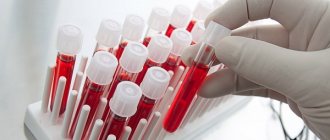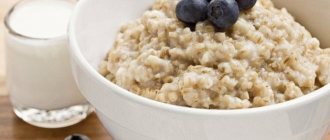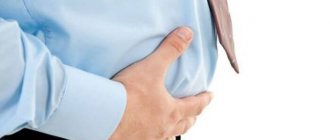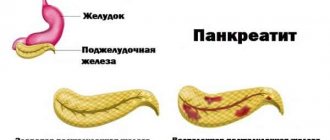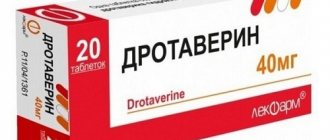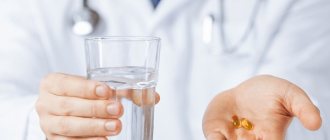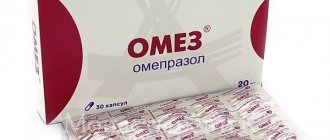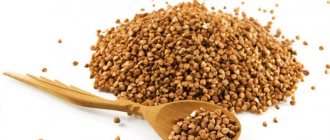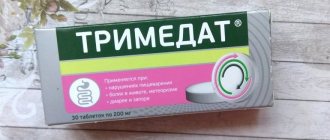Signs of other pancreatic diseases
In addition to acute inflammatory processes, there may be other diseases in the organ. The symptoms are determined by the characteristics of the pathological process and can be unique in each case. However, the symptoms of pancreatic pain always include any of the above. To make an accurate diagnosis in this case, it is necessary to conduct additional examinations, for example, ultrasound or biopsy.
Symptoms of pancreatic tumors
The detection of oncological pathology is of greatest importance, since the sooner treatment for such a disease begins, the greater the person’s chances for a full recovery. In recent years, there has been an increase in the number of patients with neoplasms of the digestive system, including the pancreas.
Tumors in this organ can arise both from cells responsible for the synthesis of enzymes and from hormonally active tissues. In both cases, symptoms resembling acute pancreatitis or exacerbation of chronic pancreatitis are noted. Depending on which part of the organ the tumor is located, additional manifestations may appear.
Options for the location of cysts in the organ
For example, with cancer of the head, this part of the pancreas enlarges, which leads to compression of the nearby bile duct. This leads to the formation of stagnation of bile, the gradual penetration of bilirubin into the blood, which is the cause of jaundice. If there is no significant pain, the patient may be suspected of hepatitis or other liver diseases.
In case of damage to the cells that make up the islets of Langerhans, signs of diabetes mellitus are likely to appear. In this case, the patient's condition may improve slightly after using standard glucose-lowering drugs or insulin.
Stones and cysts
A cyst is a neoplasm that is a cavity filled with fluid. They can appear in various organs and parts of the body. The pancreas is no exception.
Symptoms characteristic of cystic organ damage resemble manifestations of a tumor process. With significant sizes, compression of surrounding tissues and disruption of organ function is possible. Jaundice, pain under the ribs, indigestion, dyspepsia, diarrhea, and nausea may appear.
It is almost impossible to determine the cause of concern based on the clinical picture, so doctors prescribe additional examinations, the most informative of which is ultrasound. After confirmation of the diagnosis, surgical treatment is performed.
Pancreatic stones occur infrequently. Currently, the exact cause of this pathology is unclear. The disease may develop primarily due to the accumulation of salts in the tissues of the organ. Stone formation is also possible after suffering inflammatory and other pathologies of this organ. The most common location of pancreatic stones is the head. Most often, doctors discover pathology by accident when performing diagnostic procedures for other diseases.
Stones in the pancreas are quite rare
The manifestations that cause stones in the organ are also not highly specific. Patients may complain of pain in the upper abdomen radiating to the lower back or back. In some cases, there is a paroxysmal increase in pain after errors in the diet. Then it is necessary to differentiate this disease from acute pancreatitis or renal colic.
If the stone moves into the cavity of the common bile duct, an acute condition occurs. It is manifested not only by pain, but also by jaundice associated with stagnation of bile. In this case, and in severe cases of the disease, surgical treatment is recommended, which consists of removing the stone from the organ or duct.
Pancreatic diseases can present with a wide variety of symptoms. Knowing how the pancreas hurts and how diseases of this organ can manifest themselves, you can assume the presence of such a pathology in time and consult a doctor. The earlier the diagnosis is made and the earlier treatment is started, the higher the chances of a full recovery and the prevention of severe complications.
Symptoms of pancreatic inflammation
To begin with, it should be said that the symptoms of the disease can either manifest themselves sharply or practically not manifest themselves. A common symptom of the disease is pancreatic spasm, which leads to pain. Thus, the progress of enzymes necessary for the digestion of beneficial microelements is blocked and stagnation occurs. As a result of this stagnation, the tissues begin to affect each other, and an ulcer appears on their surface.
Almost any inflammatory process in the pancreas leads to fibrosis or tissue hardening. This disease, in turn, leads to a deterioration in the quality of echogenicity during ultrasound and the possibility of developing insulinoma or a hormonally active tumor. Fibrosis, like pancreatitis, can be asymptomatic, which significantly complicates the timely and correct diagnosis of the disease.
Most often, patients note such signs of the disease as belching, diarrhea and bloating. Appetite decreases, causing the patient to lose weight. Since all this leads to problems with the digestive system, symptoms such as nausea, vomiting and constipation are observed. In addition, pancreatic diseases lead to the appearance of dry skin or plaque, as well as the appearance of purple spots on the skin.
Disturbances in the functioning of the digestive tract most often lead to the retention of excess fluid in the abdomen, and dropsy is observed.
What to do during an attack?
Since a painful attack can occur at any time, every patient should know what he needs to do if the pancreas is inflamed. After all, if he can provide himself with first aid, he will have every chance to prevent serious consequences from occurring.
Speaking about how to relieve inflammation of the pancreas, it should first of all be noted that therapeutic measures should only occur under medical supervision. Therefore, when primary signs of an attack appear, you must immediately call an ambulance.
Before the doctors arrive, you can perform the following actions to help alleviate the patient’s condition:
- the person needs to be seated on a sofa or chair, tilting his torso forward (if vomiting occurs, you can substitute some kind of container);
- make an intramuscular injection of No-shpa - it will help eliminate spasm in the pancreatic ducts and improve the outflow of its contents, thereby reducing the inflammatory process and the severity of pain.
If an acute attack of pain occurs due to pancreatitis, the patient must be hospitalized immediately
No further measures can be taken before the ambulance arrives, since any incorrect action can lead to a worsening of the patient’s condition. As soon as the doctors are on site, they usually take the patient to the clinic, where they further treat him.
Treatment for inflammation of the pancreas and the occurrence of acute pain syndrome in men and women involves the following measures:
- intramuscular or intravenous administration of antispasmodic drugs;
- the use of analgesics (in this case, narcotic painkillers such as Morphine and Tramadol, which are administered intravenously, are often used).
You can read more about the medications that are used to treat pancreatitis here.
For diseases such as acute chronic and acute pancreatitis, a fasting diet is required. During this period, you should not eat any food at all. You are allowed to drink only small amounts of water. If the patient experiences severe vomiting, fever and signs of necrotic processes, antibacterial and antiemetic drugs are prescribed.
As soon as the attack can be stopped, general therapy is supplemented with enzyme agents and antacids. These drugs ensure the normalization of digestive processes in the body, improve the absorption of nutrients and help restore intestinal motility.
Treatment of pancreatitis should occur under strict medical supervision. Independent actions during periods of acute inflammation can lead to serious consequences
At the same moment, the patient is allowed to eat for the first time. And not ordinary food, but dietary food, which does not put a strong burden on the pancreas. And speaking about what you can eat during inflammation of the pancreas, it should be noted that for the first few days you are allowed to eat only:
- liquid mashed potatoes prepared in water, without salt and oil;
- jelly;
- herbal teas;
- rosehip decoction;
- low-fat fermented milk products;
- porridge with water without oil, salt and sugar.
If after the introduction of the primary diet the patient’s condition remains stable, then after a few days he can eat fish and meat dishes. Only in this case they must be steamed and thoroughly chopped. In this case, only dietary varieties of meat and fish are allowed.
Also, fruits and vegetables are gradually introduced into the patient’s diet, but not fresh, but boiled or steamed. They must be peeled, and before use they must be crushed to a puree.
If the patient's condition remains stable for 7-14 days after the attack, he is discharged, prescribed enzyme preparations and, if necessary, antacids (they reduce stomach acidity), which he will need to take for several months.
After discharge, it is necessary to strictly follow all the doctor’s recommendations, since this is the only way to prevent a recurrence of the disease and the appearance of complications due to it.
How to relieve pancreatic spasms
If a person experiences ongoing pancreatic spasms with acute pain, you should immediately call an ambulance for hospitalization. But often this condition takes you by surprise, for example, outside the city or in a small village, where it will take quite a long time for an ambulance to get there. In this case, it is worth knowing how to alleviate the patient’s condition. To do this you will need:
Often, incorrect actions to relieve pancreatic spasms lead to a serious deterioration in a person’s condition. And given the danger of the disease that causes spasms, death occurs. It is not recommended to delay seeing a doctor, endure the pain, and forget about the problem after relief. Since this attitude causes the body to become accustomed to pain and complicates not only diagnosis, but also all treatment.
Symptoms of acute pancreatitis
An important internal organ in the human body is the pancreas, which helps digest food. It also secretes many hormones and enzymes necessary for digestion. Inflammation in the pancreas causes a disease called pancreatitis.
There are two forms of the disease:
- Spicy.
- Chronic.
In both cases, the inflammatory process of the pancreas is accompanied by acute pain. If there is no appropriate treatment and the patient violates the diet, damage to necrotic tissue is observed, as a result of which the person may die.
In acute pancreatitis, the following symptoms often occur:
- pain in the hypochondrium on the right;
- girdling pain in the back;
- nausea and vomiting;
- bloating is observed;
- no appetite;
- blood pressure decreases;
- headache;
- signs of tachycardia are observed.
Moreover, the pain may ease slightly if the patient, sitting, pulls his knees towards him. Even if the attack has passed, it is necessary to seek help from a doctor to avoid serious consequences.
Questions often arise about which specialist should be consulted in order to recognize the signs of acute pancreatitis. If these symptoms occur, it is necessary to contact a therapist, who, after examining the patient’s condition, will give a referral to a gastroenterologist. He will conduct a study and prescribe therapy for taking medications and following a strict diet. If necessary, you will need to consult a surgeon and other specialists.
How to recognize pancreatic colic
In addition to spasms, a person may be bothered by pancreatic colic. They are quite easily confused with spasms and intestinal colic, but in terms of the degree of manifestation they are more pronounced. They can also lead to real shock and death. Colic develops against the background of acute pancreatitis. In this case, the person complains of tingling in the left hypochondrium or in the pit of the stomach. The severity of colic depends on the severity of the inflammation.
During the formation of pancreatic colic, excessive production of pancreatic juice occurs, as a result of which a person experiences:
- heartburn;
- sour belching;
- diarrhea;
- nausea and vomiting;
- stabbing pains.
The reasons for this condition are:
- Eating large quantities of food at night.
- Presence of fatty foods in the diet.
- Eating spicy food.
- Excessive alcohol consumption.
Important. If the disease is not treated, then sooner or later the walls of the pancreas begin to collapse.
Symptoms of chronic pancreatitis of the pancreas
The development of pronounced signs of chronic pancreatitis may be preceded by a period of mild symptoms.
In the initial stages of the disease, discomfort in the stomach, flatulence, bloating, diarrhea with fat or undigested food in the stool are observed.
Then a painful form of pancreatitis appears with the following symptoms:
- pain in the abdominal area;
- phenomena of exocrine pancreatic insufficiency;
- dyspepsia (diarrhea, nausea, vomiting);
- flatulence;
- manifestations associated with impaired bile outflow;
- disruption of the activity of the gland as an endocrine organ.
Abdominal pain syndrome
Pain occurs not only during an exacerbation. Chronic pancreatitis of the pancreas in remission can also be accompanied by pain. The area in the middle of the abdomen usually worries.
This may be due to the following reasons:
- Inflammation and changes in pancreatic tissue.
- Pressure of the enlarged gland on the plexus of nerves.
- Compression of nerves by overgrown connective tissue.
- Obstruction of the pancreatic duct.
- Formation of false cysts in the gland.
If the pain syndrome is caused by duct obstruction or false cysts, then the pain is usually felt during or after eating.
Painkillers for this type of pancreatitis do not help.
The condition improves after taking drugs that reduce pancreatic secretion.
Pain in chronic pancreatitis, caused directly by inflammation in the gland, occurs regardless of food and is relieved by taking analgesics.
In advanced cases of chronic pancreatitis, pain no longer bothers the patient, since most of the gland is already replaced by connective tissue.
In the later stages, the main symptom of the disease is manifestations of glandular insufficiency.
Signs of exocrine gland insufficiency
Exocrine pancreatic insufficiency manifests itself in disturbances in the digestion process and absorption of nutrients in the intestine.
The patient is concerned about dyspepsia:
- diarrhea (up to 6 times during the day);
- secretion of fat with feces (the feces are liquid, shiny and foul-smelling);
- nausea, sometimes vomiting
- the tongue is covered with a gray coating;
- weakness;
- body weight falls;
- poor appetite.
Further, increased bacterial growth begins in the intestines, flatulence, belching and rumbling in the stomach are observed.
Vitamin deficiency begins: the patient feels weak, his skin and hair condition worsens, and anemia increases.
If chronic inflammation of the pancreas occurs with exocrine insufficiency, this may be due to the following reasons:
- Damage to gland cells responsible for the production of digestive enzymes;
- Obstruction of the gland duct, which prevents the flow of pancreatic juice into the intestines;
- The intestinal environment becomes acidic, and protein enzymes are inactivated.
All these factors interfere with the process of normal digestion in the intestines. The result is diarrhea, nausea and vomiting.
Other signs of chronic pancreatitis
About a third of patients experience jaundice and inflammation of the bile ducts, and the blood test shows increased bilirubin.
The inflamed and enlarged pancreas compresses the bile duct.
In some patients with pancreatitis, the islet cells of the pancreas, which are responsible for the production of insulin and glycagon, are affected.
This leads to disruption of the endocrine function of the organ. Secondary diabetes mellitus develops.
Some patients experience high fever, weakness, tachycardia, decreased blood pressure, and the appearance of small red spots on the skin that do not disappear when pressed - these are signs of chronic pancreatitis, which occurs with symptoms of intoxication of the body due to fermentemia.
Symptoms
The main symptom of an attack is unbearable bursting pain, often in the upper abdomen. The local pain symptom becomes shingles in nature. It forces a person to take a special position: sitting or lying down, with his legs tucked close to his body.
The pain intensifies when pressing on the epigastric region, right hypochondrium. It is accompanied by vomiting and nausea. A characteristic sign of dyspeptic syndrome is that after vomiting it does not become easier, as happens with poisoning or toxicosis.
An acute attack is caused by blockage of the gland ducts in almost half of the cases after heavy meals accompanied by an increased amount of alcoholic beverages
If there is a stone in the ducts of the gland and its movement, the intestines are severely affected, diarrhea and (or) constipation occur, and digestion is disrupted. Diabetes mellitus often develops, which is determined by the level of glucose in the blood (above 6.5 mmol/l on an empty stomach).
During an attack, it is necessary to monitor blood pressure; it can drop sharply, and the person’s lips turn blue. In medical practice, there are cases when an attack is not accompanied by pain. Blueness or paleness of the facial skin may be alarming. Small bruises appear on the skin of the abdomen.
Feces contain undigested food debris. Stool looks shiny due to its fat content. A person does not fully receive the fatty components of food from the foods he eats and gradually loses weight.
A medical error occurs when incorrect diagnoses of intestinal diseases (colitis and enteritis) are made based on analyzes. It is necessary to simultaneously look for the cause of the disorders in the dysfunction of the pancreas. The cause of digestive aggravation is often pancreatitis.
Diet
Proper nutrition is mandatory in the treatment of pancreatitis. This diet includes the following:
- Complete cessation of drinking alcohol and smoking.
- Complete exclusion of foods with coarse fiber from the diet. These include all legumes and cabbage.
- Potatoes, carrots and cauliflower can be consumed in limited and only boiled form.
- You should completely avoid sausages, processed foods, fast food, canned food, spicy and fried foods, as well as animal fats.
- Exclude fatty foods, hard cheese, rich broths, fatty fish and meat from the menu.
- You can only drink mineral water, green tea and rosehip decoction. Rare use of herbal decoctions (chamomile, St. John's wort) is allowed.
- You can eat fruits, but not sour ones. It is best if they are served crushed. Fruit juices are prohibited.
- The consumption of chocolate, ice cream, cakes, creams and other sweet confectionery products is strictly prohibited. Instead, you can eat honey, nuts, dates, raisins and dried apricots in small quantities. You can also drink decoctions of these dried fruits.
- It is allowed to eat fish and meat dishes (chicken, rabbit), but only boiled (all kinds of steamed cutlets and meatballs).
- You can't drink sweet carbonated drinks.
- You can eat protein steamed omelettes.
- The consumption of low-fat fermented milk products (cottage cheese, kefir, fermented baked milk) is allowed. It is desirable that such products do not contain artificial additives, flavors and dyes. You can make casseroles from cottage cheese.
- You should eat vegetable soups and cereals every day.
- You will have to give up white bread for a long time. Instead, you can eat biscuits or dried rye bread.
- Seafood and seaweed are very healthy.
In addition, dietary nutrition provides for the following rules for eating and preparing food:
- All dishes must undergo thorough heat treatment.
- You need to eat often (4-5 times a day), but the portions should be small.
- Avoid eating too hot or cold foods. Their temperature should be average.
- You can't eat at night.
- You should combine the menu correctly and avoid eating hard-to-digest foods at one meal.
- To further normalize digestion, it is useful to take vitamin complexes (vitamin A, C, E and B vitamins).
- It is best to bake or boil foods.
- You will have to give up salt, pepper, sugar and other flavoring additives.
Let's consider a sample menu for a week for the treatment of pancreatitis:
- Monday:
- breakfast: oatmeal, a glass of kefir;
- afternoon snack: rosehip decoction, nuts;
- lunch: steamed cutlets, vegetable stew;
- lunch: green tea, biscuits;
- dinner: cottage cheese casserole.
- Tuesday:
- breakfast: buckwheat soup, green tea;
- afternoon snack: fermented baked milk;
- lunch: boiled fish, potatoes;
- lunch: yogurt;
- dinner: boiled beet salad, rice porridge.
- Wednesday:
- breakfast: tea with honey, dried fruits;
- afternoon snack: kefir;
- lunch: soup with meatballs, boiled asparagus;
- lunch: cottage cheese;
- dinner: carrot cutlets, oatmeal.
- Thursday:
- breakfast: squash caviar, rye bread;
- afternoon snack: yogurt;
- lunch: stewed rabbit, boiled carrot and beet salad;
- lunch: rosehip decoction;
- dinner: baked potatoes with vegetables.
- Friday:
- breakfast: steamed fish cutlets, compote;
- afternoon snack: kefir;
- lunch: oatmeal, steamed chicken chops;
- lunch: cottage cheese casserole, green tea;
- dinner: salad of tomatoes, herbs and cucumbers, beef stew.
- Saturday:
- breakfast: boiled pumpkin;
- afternoon snack: green tea, nuts;
- lunch: stewed potatoes, vegetable stew;
- lunch: fruit;
- dinner: boiled chicken breast, buckwheat porridge.
- Sunday:
- breakfast: semolina porridge;
- afternoon snack: fermented baked milk;
- lunch: chicken soup;
- lunch: green tea;
- dinner: steamed cutlets, buckwheat soup.
Pancreatitis during pregnancy
Fortunately, acute pancreatitis in pregnant women is very rare. However, this disease increases maternal and child mortality and can lead to premature birth. In most cases, pancreatitis is caused by gallstones, alcohol consumption and increased triglyceride levels in the blood. Hormonal changes and weight gain during pregnancy increase the risk of gallstones and increase triglyceride levels in the blood.
Causes of an attack
A pancreatic attack, as a rule, occurs completely suddenly, and there are several reasons for this:
- errors in nutrition;
- stress;
- drinking alcohol (even in very small quantities);
- smoking;
- inflammation of the gallbladder;
- infectious diseases;
- liver diseases;
- pathologies of the cardiovascular system;
- congenital anomalies in the structure of the pancreas, etc.
And despite the fact that there are many factors that can provoke attacks of pancreatitis, the main cause of their occurrence is poor nutrition. After all, the pancreas is the main organ for the synthesis of digestive enzymes. And if a person regularly eats food that is “heavy” for the gastrointestinal tract, the gland becomes overloaded, its work fails, which entails the occurrence of inflammatory processes in the pancreatic parenchyma.
This, in turn, causes edema, as a result of which the organ increases in size and a narrowing of the lumen of the excretory ducts is noted. Such phenomena provoke stagnation of pancreatic juice inside the gland, since its release into the duodenum cannot occur through narrowed ducts. And it contains digestive enzymes, the work of which is activated immediately after their production. And given the fact that they remain inside the organ, they begin to digest its cells, which provokes a painful attack.
Poor nutrition is the main cause of the development of acute pancreatitis and exacerbation of chronic
Important! It is for this reason that doctors strongly recommend that all their patients (even those who do not suffer from pancreatitis) adhere to proper nutrition. After all, only it will help avoid the occurrence of attacks and maintain the functionality of the pancreas.
Spasms in the pancreas: causes
The spasm is caused by increased pressure in the organ, which causes a backflow of enzymes produced by the pancreas. Against this background, an acute attack of pancreatitis, an inflammatory process, develops.
This state of affairs leads to:
- Regular consumption of alcohol in large quantities.
- Exotic dishes with excessive addition of spices, seasonings and herbs.
- Chemical components in food and drinks intended to impart a specific taste, aroma, extend the shelf life of the product - flavorings, carcinogens, preservatives, taste substitutes, etc.
Seemingly minor mistakes, such as drinking cold liquids on a hot day or eating ice-cold ice cream, can lead to pancreatitis.
Functions of the pancreas
Exocrine function. Every day, the pancreas produces 500-1000 ml of pancreatic juice, consisting of enzymes, salts and water. Enzymes produced by the pancreas are called “proenzymes” and are produced by the pancreas in an inactive form. When a bolus of food enters the duodenum, hormones are released, which trigger a chain of chemical reactions that activate pancreatic juice enzymes. The most powerful stimulator of pancreatic secretion is hydrochloric acid of gastric juice, which, when it enters the small intestine, activates the secretion of secretin and pancreozymin by the intestinal mucosa, which, in turn, affects the production of pancreatic enzymes.
These enzymes include:
- Amylase, which breaks down carbohydrates;
- Trypsin and chymotrypsin, involved in the process of protein digestion, which begins in the stomach;
- Lipase, responsible for the breakdown of fats that have already been exposed to bile coming from the gallbladder.
Additionally, pancreatic juice contains microelements in the form of acidic salts, which ensure its alkaline reaction. This is necessary to neutralize the acidic component of food coming from the stomach and create suitable conditions for the absorption of carbohydrates.
The secretion of pancreatic juice is regulated by nervous mechanisms and is associated with food intake, i.e., food of varying composition stimulates the production of juice of different volumes and enzyme content. It accumulates in the interlobular ducts, which join the main excretory duct, which flows into the duodenum.
Endocrine function. The internal secretory function of the gland is to release the hormones insulin and glucagon into the blood. They are produced by groups of cells interspersed between the lobules and without excretory ducts - the so-called islets of Langerhans, located in significant numbers in the tail of the gland. The islets of Langerhans consist mainly of alpha cells and beta cells. Their number in healthy people reaches 1-2 million.
- Insulin is produced by beta cells and is responsible for the regulation of carbohydrate and lipid (fat) metabolism. Under its influence, glucose moves from the blood into the tissues and cells of the body, thereby lowering the blood sugar level. Beta cells make up 60-80% of the islets of Langerhans.
- Glucagon is produced by alpha cells and is an insulin antagonist, i.e. it increases blood glucose levels. Alpha cells also take part in the production of the substance lipocaine, which prevents fatty degeneration of the liver. Their share in the islets of Langerhans is about 20%.
The islets of Langerhans also contain other cells in small quantities, for example, delta cells (1%), secreting the hormone ghrelin, which is responsible for appetite and stimulates food consumption. PP cells (5%) produce pancreatic polypeptide, formed by 36 amino acids and suppressing pancreatic secretion.
The destruction of beta cells leads to inhibition of insulin production, which can trigger the development of diabetes. Symptoms of this are constant thirst, itchy skin, and increased urine output.
The pancreas is in close relationship with other organs of the digestive tract. Any damage or disruption of its activity negatively affects the entire digestive process.
Symptoms of chronic pancreatitis
In the chronic course of the pathological process, the blood supply and nutrition of the cellular structures of the gland are disrupted, which entails their replacement with connective tissue. As a result, organ function is impaired, that is, enzymes and hormones are not produced by the pancreas in sufficient quantities.
Symptoms of pancreatitis of the pancreas in men in its chronic form appear as in the acute process, but not as intense. The pain syndrome is less pronounced and appears most often with errors in the diet.
Eating large amounts of fatty or fried foods, sweet carbonated water or alcohol provokes an attack of pancreatitis.
But if frequent exacerbations of the disease occur in men, then the following symptoms of chronic pancreatitis develop:
- discomfort, manifested by abdominal pain and mainly after eating;
- bloating;
- bowel dysfunction in the form of intermittent constipation and diarrhea with changes in the color and consistency of stool;
- the appearance of yellowness of the sclera and skin;
- weight loss due to impaired digestive function of the pancreas;
- decreased appetite;
- the appearance of pale and dry skin, brittle nails, hair loss due to vitamin deficiency;
- general weakness, loss of strength;
- development of asthenia with sleep disturbances, periodic headaches, irritability;
- the appearance of diabetes mellitus due to disruption of the hormonal function of the pancreas.
An increase in the symptoms of the disease forces a man to see a doctor and undergo examination by a gastroenterologist.
The nature of pain in chronic pancreatitis
In chronic pancreatitis, the nature of the pain can vary and be felt as:
- aching;
- Pulling;
- piercing;
- drilling;
- stupid.
This pain can last for several hours. If it is not stopped and therapy to relieve inflammation is not started, the pathological process can cause serious complications that can lead to irreversible processes in the pancreas and the practical cessation of its functioning.
Causes of inflammation of the pancreas
Inflammation of the pancreas occurs primarily due to an incorrect lifestyle.
In total, doctors count more than a hundred causes of pancreatic diseases.
Among them, the most common are excessive alcohol consumption and addiction to bad habits such as smoking tobacco.
In addition, the following causes of inflammation in the pancreas are widespread:
- cholelithiasis;
- taking certain medications;
- infectious diseases;
- metabolic disease;
- the presence of worms;
- various stomach injuries, etc.
In acute pancreatitis, girdle pain appears that occurs suddenly. Attacks of pain can last for hours or several days. In this case, it is necessary to quickly hospitalize the patient and carry out treatment in a hospital setting under the strict supervision of a doctor.
Chronic pancreatitis does not manifest itself so aggressively. However, it has almost irreversible consequences for the human body. As a rule, in the event of the death of working cells of an organ, connective tissue is created that does not produce hormones and enzymes. As a result, a person may experience intestinal diseases and diabetes.
In extremely rare cases, pancreatic cancer occurs.
Diagnosis and treatment
Pancreatitis has a clear, specific clinical picture, which allows the gastroenterologist to make an initial diagnosis after examination, palpation, percussion and collection of the patient’s medical history. To determine the severity of the disease, it is necessary to undergo a complete examination.
Diagnostic methods:
- clinical blood test - allows you to see the degree of the inflammatory process;
- urinalysis - with pancreatitis, amylase levels increase;
- coprogram;
- blood sugar test;
- biochemical blood test - determines the level of pancreatic enzymes and liver function;
- Ultrasound, CT, radiography of the abdominal organs;
- EGDS - using a small camera to study the condition of the gastrointestinal tract from the inside.
Drug treatment
During an acute attack of the disease, a person is given intravenous drips of drugs to eliminate dehydration and normalize blood pressure, suppress the enzymatic activity of the gland, and eliminate pain. Then drug treatment is started, the purpose of which is to eliminate the symptoms of the disease and restore the functioning of the organ. Most often, tablets are used; in severe cases, injection solutions are used.
How to treat pancreatitis - doctor's advice:
- antispasmodics – Drotaverine, Papaverine;
- anticholinergics – Atropine;
- antibiotics – Trichopolum, Tobramycin;
- drugs to reduce the secretion of gastric juice - Orthanol, Ranitidine, Histodil;
- enzymes – Creon, Mezim, Pancral;
- sorbents – Enterosgel;
- medications to reduce the production of pancreatic enzymes - Gordox, Kontrikal.
For pancreatic necrosis, blockage of the gland ducts with stones, traditional treatment methods will not help; surgical intervention is necessary. The entire pancreas is rarely removed, since the operation is complex and fraught with complications.
Folk remedies
Alternative medicine methods help relieve inflammation and other manifestations of pancreatitis, prolong the remission stage, but they should be used in combination with drug therapy, only after agreement with the attending physician.
Simple recipes for treating pancreatitis at home:
- Pour 250 ml of boiling water over 20 g of chopped walnut leaves, simmer over low heat for 5 minutes, cool, strain. Take 70 ml three times a day.
- Mix chopped blueberry leaves and bean pods in equal proportions. 1 tbsp. l. pour 220 ml of boiling water over the mixture, strain after a quarter of an hour. Drink 100 ml three times a day before meals.
- Pour 500 ml of water into 100 g of unpeeled oat grains, cook over low heat for 40 minutes, grind the mixture, cook for another 20 minutes. Strain the resulting decoction and drink 100 ml three times a day.
- Pour 500 ml of cold water into 5 g of crushed dry immortelle and leave for 8 hours. Drink 200 ml once a day for 20 days.
To improve the digestion process, people with inflammation of the pancreas need to eat fresh strawberries, gooseberries, persimmons, cherries, drink juice from cabbage, celery, currants, and raw potatoes.
Effective antispasmodic drugs
The degree of therapeutic effect of antispasmodics is largely determined by the severity of the manifestations of pancreatitis, the course of the disease (acute or chronic), the dosage form of the drug (tablets or injections), age and other internal diseases that complicate inflammation in the pancreas.
Let's look at the list of the main antispasmodic drugs prescribed for pancreatitis.
Drotaverine
Drotaverine for pancreatitis is one of the most common, effective and affordable antispasmodics. The medicine has a long-lasting and pronounced relaxing effect on the smooth muscles of internal organs and blood vessels. It is on the basis of drotaverine that such a well-known drug as No-shpa has been developed, which eliminates spastic contractions of the muscles of the abdominal organs, including the pancreatic ducts. Drotaverine tablets begin to act 25-40 minutes after administration, so they are used in the absence of severe pain and vomiting in the patient. An intramuscular injection of Drotaverine or No-shpa has a therapeutic effect within 5-7 minutes.
